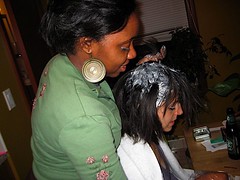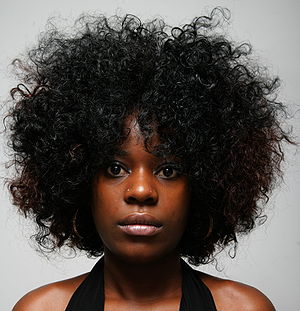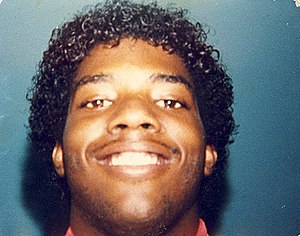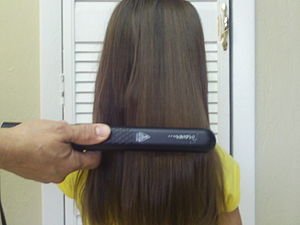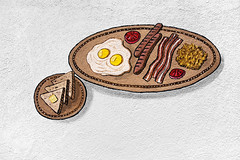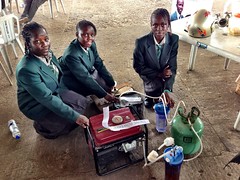| (intimicacy revealed) homemade hair relaxer by angela (Photo credit: celinecelines) |
Although it is not often discussed, wearing a natural hairstyle has been a contentious issue for much of the African continent. During the colonial era, the Western aesthetic was the dominant standard of beauty in Africa. Looking White provided Africans with social and political advantages under the colonial system where Africans that looked more like their “colonial masters” were more likely to get work and gain other privileges.
This was very evident in countries like South Africa wear the ‘pencil test’ determined your racial classification, and hence your social, economic, and political standing. Therefore Africans began using
| English: Unidentified African American woman with Afro-textured hair, cerca 1850 (Photo credit: Wikipedia) |
By 1877 Garret A. Morgan had invented the lye hair relaxer in the USA and its use soon became the more popular method of straightening hair. Chemical relaxers offered longer lasting results (often called ‘permanent’ or ‘perm for short’) and soon became the preferred method of straightening hair. Hair straightening increased immensely in the 1900s because of Madam C.J. Walker and her multimillion dollar hair straightening business.
Walker, an African-American entrepreneur, played a major role in the promotion of hot combs, relaxers and other hair straightening products throughout the USA. The use of these products to straighten curly hair became more popular in the Caribbean and Africa as well because fashion trends often traveled across seas.
Politics and Hair
| English: Natural hair (Photo credit: Wikipedia) |
In many African countries another popular natural style, dreadlocks, were worn by the Rastafarian populations and liberation fighters in the 1960s like the Mau Mau in Kenya. Like with the Afro, this natural hairstyle became associated with dissidents or ‘trouble-makers’.
The illegal use of marijuana by the Rastafarian also linked locks to drug usage which is a taboo in contemporary main stream African societies. Hence, many Africans wearing locks were automatically seen as criminals and vagabonds.
Alternative natural styles like cornrows (plaits) and braids have also faced various forms of opposition over the years in some African institutions (i.e. schools and workplaces). In brief, the wearing of natural hairstyles in Africa has not been without its stereotyping and push-back from members within African societies.
Return of the Relaxer
| A man with a Jheri Curl (Photo credit: Wikipedia) |
In part, it was due to the political statements natural hair made. By the new millennium, Africans that did not want to use processors were perceived as old fashioned or unwilling to embrace “modernity”. Kinky hair was associated with “backwardness”, rural areas and village life. Those that embraced western aesthetics were perceived as more sophisticated, fashionable, urban, and modern.
They did not want to get caught with "village hair"! The standard of beauty continued to be set by the Global North (West) and reinforced through television, magazines and social practices like preferences in hiring. Therefore, African hair fashions are influenced by aesthetics in the west which in turn were dominated by White aesthetics.
In spite of the opposition faced by those wearing natural hair, in recent years, Africans in urban areas have been embracing the ‘natural’ look. More Black African women are now wearing afros, dreadlocks and many other variations.
Similarly, there has been an increase in popularity of hair extensions, pieces, and wigs that are kinky or curly or closely resemble the hair texture of the majority of Black African women. This new trend in Black women’s hair care that is currently sweeping across the African continent is a welcome move for many reasons. One pressing reason is that chemical hair relaxers have been linked to several heath problems.
How Relaxers Harm Us - The Medical Risks
Recent studies indicate that there is a link Black hair care relaxers and health risks. Research in this area has been under researched in the past but we need to take heed of the existing research and the new revelations.
There is a plethora of science-backed concerns about Black hair products. The Chemicals used in Black hair products such as relaxers, enter the body through the scalp, particularly when there is a burn or cut on the skin (this includes non-lye relaxers). They upset the internal chemical balance which leads to complications.
These topical applications can also cause chemical burns or blindness. Black hair care products (relaxers in particular), have been linked to ailments such as reproductive problems, fibroids, heart disease, cognitive disorders, cancers, early puberty, altered immune systems and other health risks. Many of these health risks are life-threatening and therefore should not be ignored by African women.
Many African women still do not know that they are risking their lives by straightening their hair. It is actually a topic that can and should be addressed with other women’s health issues. The ministries of health should work to create public awareness about the dangers of relaxers, and greater regulations are needed of harmful products that enter the market.
In the United States, the Safe Cosmetics Act is being debated that would ban unsafe products in hair care products sold in salons. For African women living in countries where changes in legislation can be slow or where regulation can be difficult women need to exercise greater agency on matters of their health. It is important that African women pay attention to the labels in the hair products and avoid relaxers altogether.
| English: Example:hair being straightened with a regular curly iron. (Photo credit: Wikipedia) |
As an example, the term ‘good hair’ is still a part of African vocabulary in many countries. Although some use the term to refer to hair that is more manageable or easily combed, it typically means having European traits or “close to white”.
This shows that the aesthetics in Africa still place Caucasian hair as the standard which African women have to live to – even at the risk of their lives. As Marcus Garvey, the founder of the Universal Negro Improvement Association (UNIA) aptly notes, “take the kinks out of your mind…instead of out of your hair.” Our attitude towards natural hair needs to improve. ‘Good hair’ for African women should ideally refer to hair that is healthy and free from damaging chemicals.
There are health benefits to going natural. The resurgence of chemical-free or natural hair styles should be conceived as a health and wellness change. There are many alternatives to hairstyles using relaxers. This includes dreadlocks, corn rows (plaits) and hair braiding. Various wigs, falls, hair extensions or other hair pieces do not require chemical hair straightening products and are viable substitutes. African women should continue to embrace ‘natural’ styles not only because it is in fashion, but also because of the associated health benefits.
A version of this article was publisehed on Africa on the Blog on May 28th, 2013
